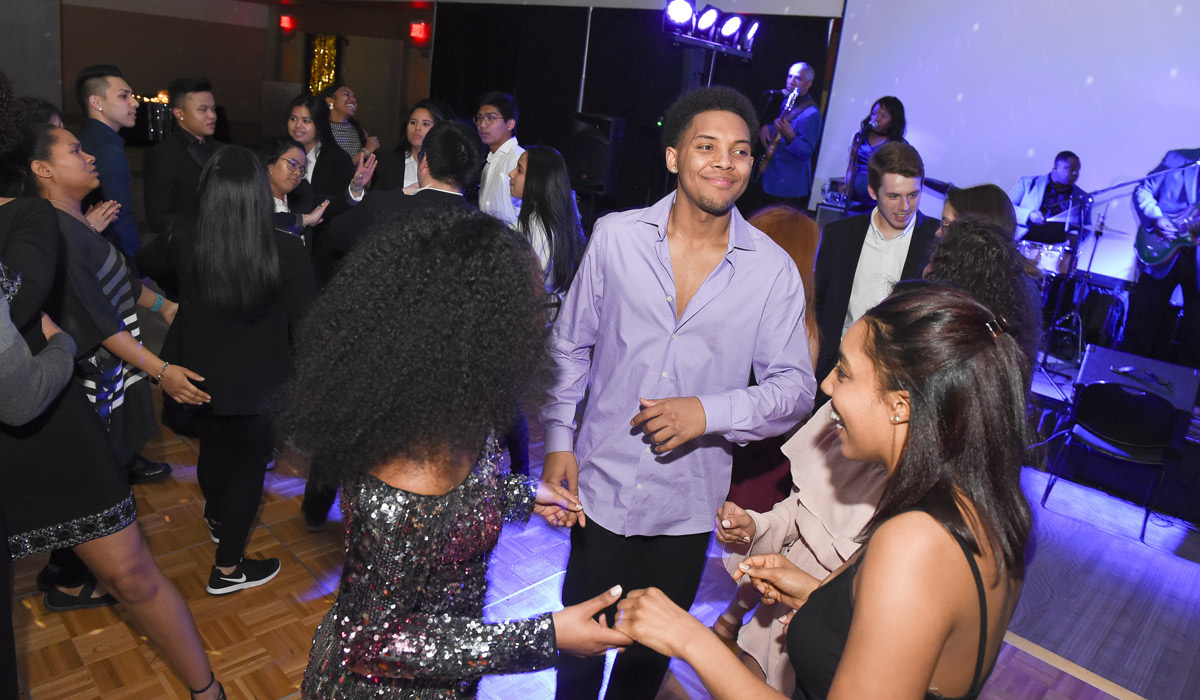

On a Sunday evening in mid-February, more than 60 Catholic University students packed a room in the the Edward J. Pryzbyla University Center to share a meal of fried chicken, macaroni and cheese, collard greens, and cornbread. As students ate, they learned about the rich history of soul food during a presentation from the Black Student Alliance (BSA).
Following the dinner, students headed over to St. Vincent de Paul Chapel for the 9 p.m. Mass, one of the most popular weekly worship opportunities among students. This week, however, the Mass was a little different. It featured a gospel choir from nearby Trinity University. Rev. Jude DeAngelo, O.F.M. Conv., University chaplain and director of campus ministry, delivered a homily about the history of black Catholics in America.
The soul food dinner and gospel Mass are held annually by the BSA to celebrate Black History Month.
“The whole point of [these events] is to share with Catholic University a part of our tradition,” said Ashley Duffoo, a senior psychological and brain sciences major who is co-president of BSA. “The dinner highlights our own food traditions and preferences. We also wanted to share our church experience and show how we express our faith to the campus community.”
The BSA also hosted a Motown-themed dance party on Feb. 23. The event featured a local Motown band, food from D.C. soul food restaurant Oohs and Aahs, a performance by the Howard University step team, and a dance performance by the Filipino Organization of Catholic University Students.
“We picked the Motown theme because it was a really great time for music and success in the black community,” Duffoo explained. “Motown music was appreciated by every person of every race so it’s a perfect era to celebrate.”
Duffoo, who has Haitian and St. Lucian heritage, hopes these events help the larger University community understand and appreciate black culture. She also hopes they serve as an invitation to join BSA, which draws approximately 40 people to its semi-monthly meetings.
Other student organizations on campus also organized events to honor Black History Month. On Feb. 6, the Music Graduate Student Association hosted a presentation by Eileen Guenther, professor of church music at Wesley Theological Seminary. The event, based on her book In Their Own Words: Slave Life and the Power of Spirituals, integrated first-person narratives of slave life, original commentary, musical performance, and congregational singing. On Feb. 12, Delta Sigma Theta sorority hosted a Black History Month edition of Family Feud.
In the Columbus School of Law, the Black Law Students Association (BLSA) and the Judge Kathryn J. DuFour Law Library have partnered on a new exhibit titled “African Americans in Times of War: An Exhibit Honoring CUA Law School Veterans.” The exhibit, located in the lobby of the DuFour Law Library, profiles three current Catholic University law students who are military veterans. In the exhibit, the students recount their military service and share what influenced them to pursue a legal education.
“I consulted the Library of Congress Veterans History Project for help with interviewing veterans about their service,” explained Frances Brillantine, who, as head of access services for the library, assisted with the project. “I wanted to understand and convey the individuality of each veteran's personality and experiences. All three veterans graciously shared their memories and impressions with me. I hope viewers of the exhibit learn as much as I did.”
The exhibit will be on display until May 25. It can also be viewed online.
The BLSA also hosted a Feb. 21 civil rights panel on the 50th Anniversary of the Fair Housing Act, the 50th year after Dr. Martin Luterh King’s assassination, and present issues.
“The breadth of Black History Month programming organized by the Black Student Alliance, the Black Law Student Association, Delta Sigma Theta, and the Music Graduate Student Association has been impressive,” said Ferentz Lafargue, director of the University’s Center for Cultural Engagement. “That many of these programs were spearheaded by students is all the more impressive and serves as a vivid reminder of how students have often been at the vanguard of celebrating and documenting African-American history on their campuses."